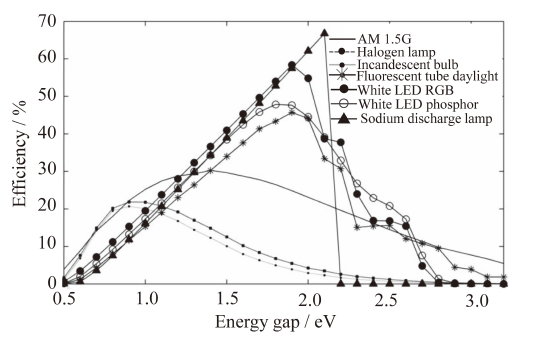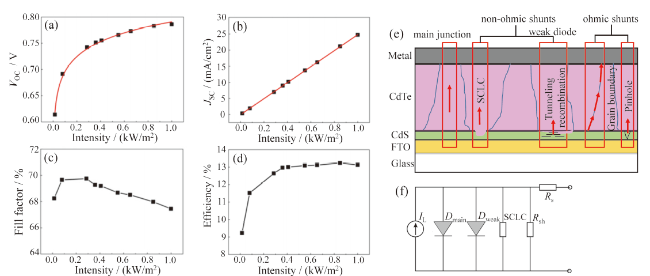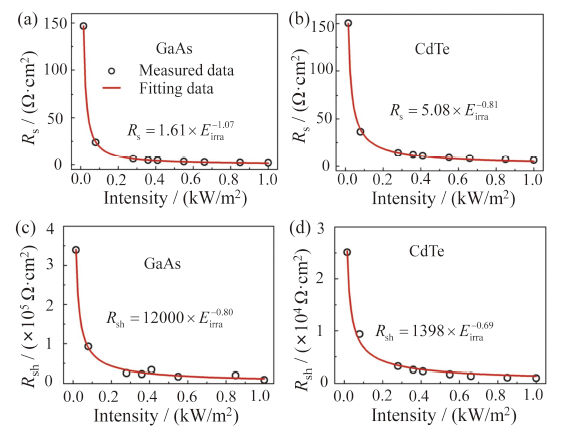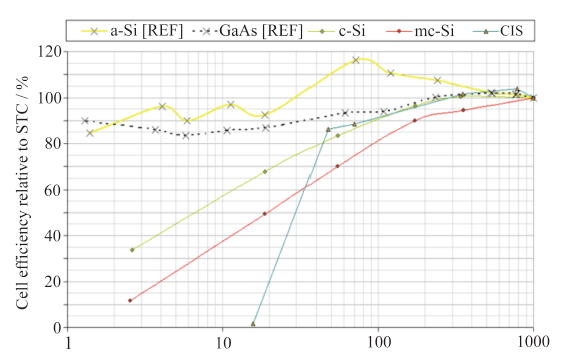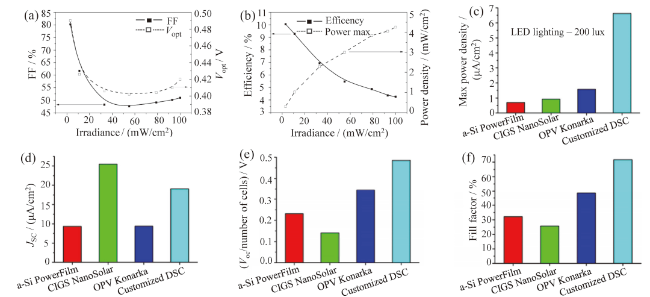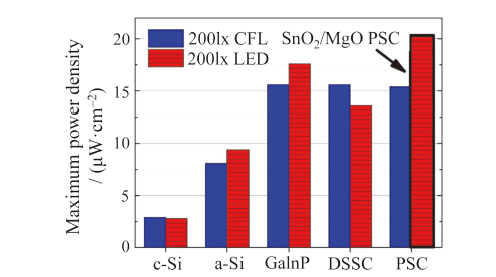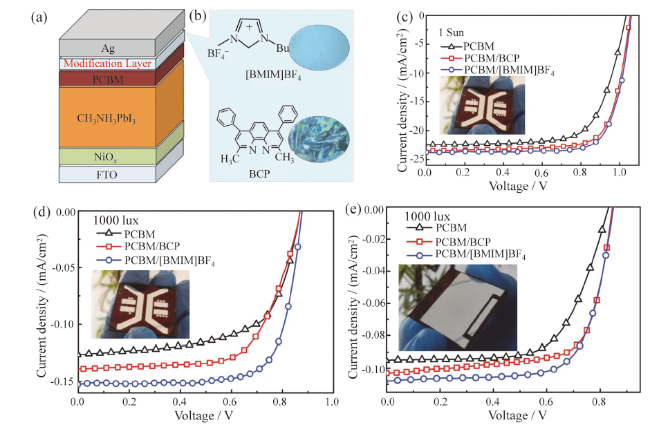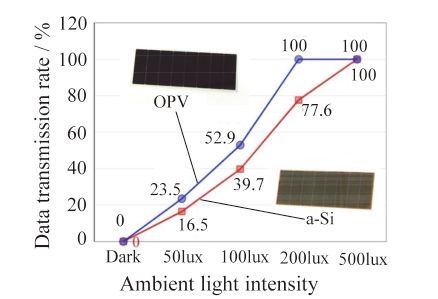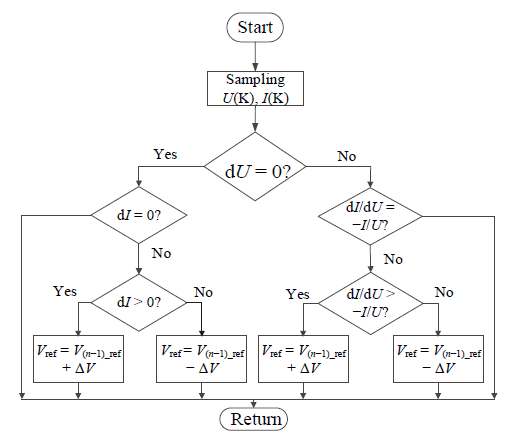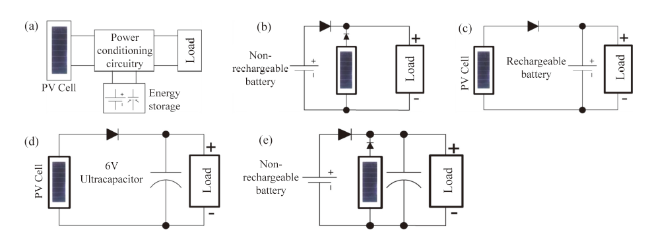0 引言
Fig. 1 One cycle of the system under ideal circumstances图1 理想情况下系统的一个循环周期 |
1 高效率采集室内光能
1.1 带隙的影响
Fig. 2 The spectrum of a standard sunlight and different indoor light sources图2 一个标准太阳光与不同室内光源的光谱 |
1.2 串并联电阻的影响
Fig. 4 Output characteristics of CdTe solar cells in 0.015-1 sun low light environment; (a) open circuit voltage; (b) short circuit current; (c) fill factor; (d) efficiency; (e) CdTe solar cells schematic diagram of leakage channel; (f) equivalent circuit model of CdTe solar cells[9]图4 在0.015 ~ 1个标准太阳光照下,CdTe光伏电池的输出特性;(a)开路电压;(b)短路电流密度;(c)填充因子;(d)转换效率;(e)CdTe光伏电池漏电通道示意图;(f)CdTe光伏电池的等效电路模型[9] |
1.3 不同光伏电池的影响
Fig. 7 PAN/EC/PC:quasi-solid DSSCs of Pr4NI electrolyte[27]: (a) variation of fill factor and maximum power output voltage with light intensity, (b) conversion efficiency and maximum power output change with light intensity; photovoltaic parameters of the flexible devices under LED lighting at 200 lux[28]: (c) maximum power density, (d) JSC, (e) ratio of VOC to the number of series connected cells, (f) FF图7 PAN/EC/PC:Pr4NI电解质的准固态DSSCs中[27]:(a)填充因子和最大功率时的输出电压随光强度的变化,(b)转换效率和最大功率输出随光强的变化;各类柔性太阳电池在200 Lux Led光下[28]:(c)最大功率密度,(d)JSC,(e)VOC与电池串联数量的比值,(f)FF |
Fig. 9 (a) Schematic diagram of inverted p-i-n structure PSCs; (b) the molecular structure of [BMIM]BF4 and BCP and the corresponding optical micrograph; PSCs (9 mm2) based on PCBM, PCBM/BCP and PCBM/[BMIM]BF4 ETLs structure: (c) J-V curves under AM 1.5G, (d) J-V curves under 1 000 Lux indoor illumination, (e) 4 cm2 J-V curves under 1 000 Lux indoor illumination[35]图9 (a)倒置p-i-n结构PSCs的原理图;(b)[BMIM]BF4和BCP的分子结构及相应的光学显微图像;基于PCBM、PCBM/BCP和PCBM/[BMIM]BF4 ETLs结构的PSCs(9 mm2):(c)在AM 1.5G标准光照下的J-V曲线,(d)1 000 Lux的室内照射下的J-V曲线,(e)4 cm2在1 000 Lux的室内照射下的J-V曲线[35] |
Fig. 10 Modeling the SQ limits of two artificial light sources: (a) emission spectrum; (b) when the light source is FT, the origin of energy loss of each value of Eg; (c) comparison of SQ limit efficiency of various values of Eg with the limit of standard solar spectrum (AM 1.5G); (d) when the light source is WLED, the origin of energy loss of each value of Eg; (e) J-V curves of large area PSC [MA0.85Cs0.15Pb1(I0.85Br0.15)3] measured at 200 Lux, 600 Lux and 1 000 Lux under FT illumination[36]图10 两种人造光源的SQ极限的建模:(a)发射光谱;(b)当光源为FT时,Eg各值能量损失的起源;(c)Eg各值的SQ极限效率与标准太阳光谱(AM 1.5G)的极限比较;(d)当光源为WLED时,Eg各值能量损失的起源;(e)大面积PSC[MA0.85Cs0.15Pb1(I0.85Br0.15)3] 在FT照明下在200 Lux、600 Lux和1 000 Lux下的J-V曲线[36] |
2 最大功率点跟踪
2.1 扰动观察法
2.2 电导增量法
2.3 开路电压比例系数法
2.4 短路电流比例系数法
2.5 室内最佳MPPT控制技术
Table 1 Main features of MPPT control technology commonly used at present[56]表1 目前常用的MPPT控制技术的主要特性[56] |
| MPPT Technique | Reach MPP? | Periodic tuning? | Convergence speed | Implementation complexity |
|---|---|---|---|---|
| P&O | yes | no | varies | low |
| INC | yes | no | varies | medium |
| Fractional VOC | no | yes | medium | low |
| Fractional ISC | no | yes | medium | medium |
3 储能方式选择
3.1 可充电电池
3.2 超级电容
3.3 混合供电
Fig. 16 (a) Structure diagram of solar cell indoor light energy collection system; (b) structure diagram of solar cell indoor light energy collection system based on no energy storage module; (c) solar cell indoor light based on rechargeable battery energy storage module Structure diagram of energy collection system; (d) structure diagram of solar cell indoor light energy collection system based on super capacitor energy storage module; (e) structure diagram of solar cell indoor light energy harvesting system based on non-rechargeable battery and super capacitor hybrid energy storage module[7]图16 (a)光伏电池室内光能采集系统结构图;(b)基于无储能模块的光伏电池室内光能采集系统结构图;(c)基于可充电电池储能模块的光伏电池室内光能采集系统结构图;(d)基于超级电容储能模块的光伏电池室内光能采集系统结构图;(e)基于不可充电电池与超级电容混合储能模块的光伏电池室内光能采集系统结构图[7] |






